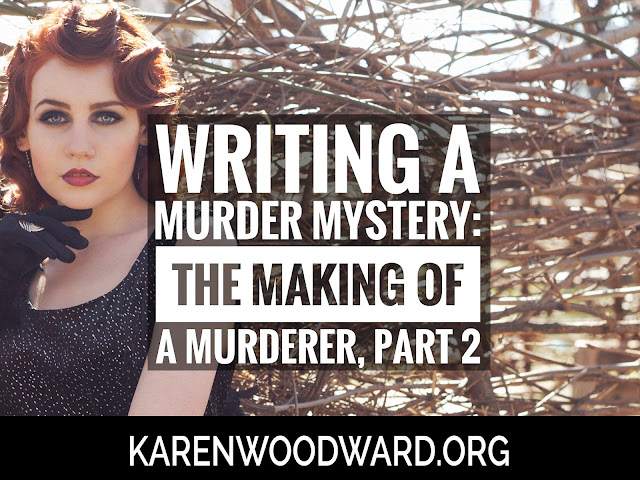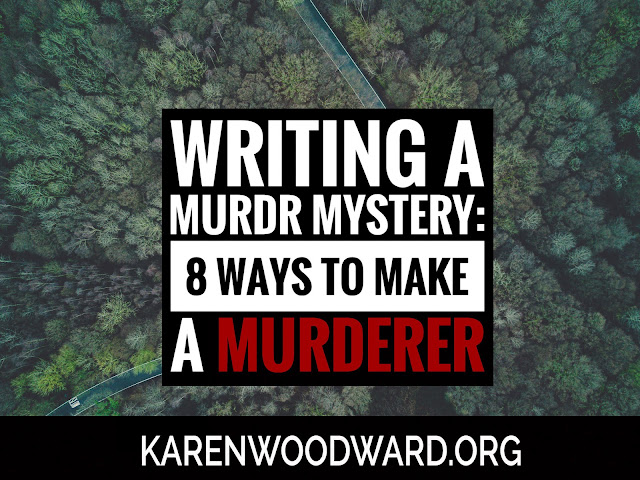This post is part of a series of articles on how to write a murder mystery. I plan to write an article about each character type: the murderer, the detective, the detective’s sidekick, the police representative, the first victim, the suspects, and the experts.
For the last couple of days we’ve been examining how to write a murderer your readers will love to hate (to see an index of these posts see How To Write A Murderously Good Mystery).
In my last post I said that, arguably, the murderer was the most important character in the story. That’s because it’s the antagonist that makes us root for the detective. After all, if the detective had no obstacles to overcome, if there was no pressure, no ticking clock, the story would be dull. Without the antagonist—the murderer—there would be no entertainment. No excitement. Why? Because the protagonist wouldn’t be TESTED. He wouldn’t be put through a crucible, be transformed and come out the other side with the tools, the ability, to solve the mystery.
The detective IS the most important character in a murder mystery because this is the character your reader needs to love, or at least love reading about. This is the character the reader needs to identify with (and, also, with the detective’s helper, but more on that later).
If you plan on writing the story from the first person perspective there are really only two choices for your viewpoint character: the detective or the detective’s sidekick. If you choose the detective then your readers will be even more likely to identify with the detective.
Keep in mind that in a murder mystery the main focus is on entertaining your reader. So let’s ask ourselves, what characteristics should the detective have to make folks love reading about him or her?
Note: I've included this material in my book: How to Write a Murderously Good Mystery: The Major Characters.
7 Characteristics Every Detective Should Have:
Everything in this post stems from this: THE DETECTIVE SHOULD BE MEMORABLE. Why? Because a memorable character has nearly all the needed characteristics of a lovable character. What is needed, in addition, is to SHOW the reader the kind of person the detective is, to expose their character. This is done mostly in sequels, but I’m not going to go over that today. Here we’re confining ourselves to characterization and setting.
I like examples, so let me list a few characters I think are memorable: Sherlock Holmes, Hercules Poirot and Mr. Monk.
(For more about how to make memorable characters see: Crafting Interesting Characters.)
Most of the time, dramatic equates to memorable. We know drama when we see it, but what creates drama? What characteristics make a detective interesting?
7 Characteristics That Make a Detective Interesting
1. Exaggeration
A dramatic character is a memorable character. Think of Carrie from Stephen King’s story of the same name. Carrie White, a traumatized young girl, is pushed too far, snaps, and kills half her town. Carry isn't just telepathic, she's the most powerful telepath who ever existed!
That's extreme.
Or take Lee Child's hero, Jack Reacher. Reacher is 6'5'' tall, has a 50-inch chest, and weighs about 250 pounds. He’s a physical wrecking machine.
That's extreme.
Mr. Monk is scared of a lot of things and some of these we can understand. It is a rare (and perhaps slightly odd) person who has never been the least scared of heights. But I don’t know anyone who is scared of the sheer number of things Mr. Monk is. They’re in the hundreds! But the key thing isn’t JUST that Monk is just scared of many things most normal folks aren’t (milk for instance!), it is that he is scared of them to an insane degree.
That’s extreme.
All of these characters are popular and, as you can see, quite memorable. While I can’t guarantee that any memorable character will be a popular character, I CAN guarantee that if your character ISN’T memorable they won’t be popular.
Why does exaggeration work? Two reasons:
a. Wish fulfillment.
Humans crave excitement. Most folks would rather read about a mercenary who is a 6'5'' mountain of man-muscle than about a man who makes a good wage, has 1.6 kids, takes a vacation a year and for whom a speeding ticket is a major event.
b. Exaggerated traits are memorable.
An exaggerated, extreme, over-the-top trait captures one's imagination. It’s memorable.
As I’ve said, this quality of being memorable is critical. If your readers can’t remember your character they won’t ever feel emotionally attached to her. The more a reader remembers about the characters we create the better the chances are of them turning the page.
- Without going overboard, think about what is exciting about your character? What characteristic of his makes you smile, what do you especially like about him?
- Are your character’s tags and traits memorable? What makes them memorable?
2. Exotic Setting
Exotic setting, as the name suggests, has to do not only with the character but the PLACE/SETTING and the character’s OCCUPATION.
PLACE/SETTING. Instead of living in an unexceptional apartment on an unexceptional street in an unexceptional town give the character a living space that’s exotic. Of course what’s exotic to me may not be exotic to you so here the writer must be guided by their own tastes. (A trip to Hawaii would be exotic for me but not so much to folks who already live there!)
Batman had his Batcave, Superman had his Fortress of Solitude, Sherlock Holmes has 221b Baker Street, Lieutenant Columbo had his car, and Poirot had his (fastidiously arranged) London apartment.
- Where does your detective live?
- What is exotic about your detective’s lair?
- What does your detective’s lair say about him? How does it do this? What characteristics make it representative of the detective?
OCCUPATION. All things being equal it's more interesting for a character to be a wizard or a CEO or even an archaeology professor than to be an ordinary dad or mom with an ordinary job.
Also, start thinking about what the setting is going to be for the Special World of the Adventure. An exotic resort? Small English Village? Plane in flight? Wherever you decide to place the lion’s share of the story keep in mind that the primary job of the setting is to CREATE CONFLICT and REVEAL CHARACTER.
(To read more about the Special World of the Adventure see: The Structure of Story)
- If your detective isn’t a professional, what does she do for work? How does this add to her exoticness, to her memorability?
- Where will the lion’s share of your story take place? How will this help to create conflict between the detective and his allies?
- How will the setting reveal the detective’s character?
3. Active Introduction
What we do—how we behave—is just as much a part of who we are as how we dress or what we think. So it should come as no surprise that how we introduce a character has an enormous impact on the reader. How we introduce a character will go a long way to determining whether your reader will remember the character as well as HOW he or she will be remembered.
In the character’s active introduction you want to do something CHARACTERISTIC, UNIQUE and MEMORABLE.
a. Characteristic Introduction
We can make a character's introduction characteristic by using MEMORABLE tags and traits. Determine which tags and traits are most important to the telling of your story. These are the ones you want your readers to remember so these are the ones that should be showcased when introducing the character.
For example, think of ...
Columbo. He loves his shabby raincoat, can never find a pencil, and always lulls the murderer into a false sense of security. He always gets his man/woman.
Hercules Poirot. He has a very old-fashioned, exaggerated, mustache that he fusses over endlessly. He is fastidious. He dresses in a suit, the cut of which is outdated and old-fashioned. He appears (especially when he wants to) excessively foreign. And he is brilliant.
Mr. Monk. The man was scared of ... well, nearly everything. Even milk! He was a germaphobe. He had trouble leaving his home unattended. If even the smallest thing was out of place he obsessed over to the point he became paralyzed. And he was the best detective in the world because he noticed all those little things others didn’t. As Mr. Monk always said: It’s a gift ... and a curse.
You get the idea. In each of these cases there are a few characteristics that fix the character in your mind and, afterward, act to bring the character back to life in your imagination.
The trick is to take the character’s tags and traits and use them to introduce the character in a way the reader will remember. (I’ll have more to say about this later.)
A couple of things to keep in mind:
Unique
In order for an action to be characteristic it must be unique to the character. For example, if white-blond hair is one of a character's tags then no other character should have white-blond hair.
Similarly, if one of your character's tags is their beaten up leather jacket, then no other character should have a beaten up leather jacket. (That said, another of your characters could have a pristine leather jacket, this would help to compare and contrast the two people, who they are, their characters, their values.)
Memorable
Although just about anything can serve as a tag, it needs to be memorable (something exaggerated, fun, or linked to a significant event in the character's life). So, for instance, Jim Butcher has made Harry Dresden's staff one of his tags, as well as his shield bracelet. Then, to make extra sure his readers will remember, he links these tags to significant events in the character's backstory.
- What are your detective’s UNIQUE, MEMORABLE tags and traits?
- How will you introduce the detective? How will you introduce him or her to your readers for the first time such that a) the introduction reflects the character’s essence and b) readers will remember them?
b. Characteristic Action
We've seen that each character should have a few memorable qualities which are captured by their tags and traits. We need to use the character's introduction to indelibly inscribe the essence of that character in our readers' minds. (No pressure or anything! This is why I HATE writing openings.)
All things being equal, the character should do something that only they can do, something that is exaggerated, over the top. Something that will allow the reader to grasp—and remember!—the essence of this character. Jim Butcher does this with his wizard, Harry Dresden.
In the 6th book of his awesome Dresden Files series, Blood Rites, Harry Dresden is in the midst of fighting monkey demons trying to save a litter of ... can you guess? That's right, puppies! Can it get cuter than that?! Talk about pulling one's heartstrings. The book is a terrific read even if you haven’t read any of the other books in the series.
If you haven't read Butcher's Harry Dresden novels, think James Bond. If you've never heard of James Bond, the opening sequence of the movie will tell you everything about him you need to know. Curvy young women wearing barely enough to clothe a toothpick swoon over him, he is suave, a skilled fighter, a stone cold killer and Britain’s last, best, hope.
In general, you want the reader to be able to think, afterward, "Yes, that was SO them." Like Harry Dresden nuking a huge demon-monkey in the opening pages of Jim Butcher's Blood Rites.
- What are your detective’s characteristic actions? What could he/she do that would be both unique to them AND completely awesome?
4. True to Life: Verisimilitude
Unbelievable characters are boring characters.
So far we’ve focused on exaggeration to help us make our character’s traits, tags, and actions memorable. Now let’s make sure they’re believable.
As we make tags and traits more exaggerated we need to keep in mind that our character still needs to seem true to life or at least plausible. This is the difference between, say, DCI Tom Barnaby (from Midsomer Murders) and Superman. Superman requires a certain suspension of disbelief that Barnaby doesn’t. After all, Barnaby doesn’t have super-strength nor can he fly!
Part of how we make sure a character seems true to life EVEN THOUGH she has several exaggerated traits that lifts her above the mainstream is to show her emotions to the reader. And how does one do THIS? Two ways: Mini-sequels and (as I’ve already mentioned) tags and traits.
Mini-sequels
Don't worry about this too much right now, but the best way to give readers the sense that your character is a real person is to show the emotions, reactions and decisions that he has in response to, for example, a disastrous setback.
First, we need to show his EMOTIONAL reaction.
Second, we need to show how his emotion is followed by thought, by REFLECTION. We need to show him considering what occurred, trying to figure out what went wrong, what he should have done differently. Perhaps show him regretting his choices.
Third, we need to show him asking himself the question: "What now?" That is, spinning out various possible PLANS for future action.
Finally, the detective CONSIDERS the courses of action open to him and chooses what he thinks is the best one.
In the next scene we show readers the detective implementing his choice by ACTING in a believable way unique to them.
Note: For more on sequels see my article: The Structure of Sequels.
- If you have a chapter or two already written, look through them. Do they contain a sequel or at least one mini-sequel? If your characters don’t jump off the page, think about beefing up either the number of sequels or their length.
Tags and Traits
Let’s take each of these in turn.
Tags
What is a tag? Think of Hercule Poirot. His large, obvious, antiquated mustache that he is inordinately fond of is a tag. His old-fashioned clothes are a tag. His fastidiousness, however, is a trait (we’ll look at traits, below).
You want to have two or three tags per significant character, more if you like. You use these tags when you introduce the character for the first time and, after that, every time they are reintroduced after being off-stage for any significant period of time.
It’s important that each character’s tags be unique (otherwise the characters won’t be as memorable). So, for example, you only want one character with bleach-blond hair IF you’re using that as a tag.
How does your character talk? What sort of expressions do they use? People born in the south tend to use different expressions than do people from the north, etc. This could be a tag. The WAY a person talks can be a tag. If a person teaches at the university they might use long sentences and unnecessarily long words.
In general, anything that separates your character from another character can be a tag. Does your character tend to run their fingers through their hair or blink rapidly when they’re nervous or shuffle their feet? Those could be tags.
Is your character optimistic? Pessimistic? Do they love playing practical jokes? Those could be tags! Vizzini in The Princess Bride continually misusing the word "inconceivable" was a tag because it uniquely differentiated him from all the other characters. Also, it helped reveal the essence of his character.
When you’re thinking about tags, think of what differentiates your character in terms of: appearance, speech and mannerism. (For more on this see Dwight V. Swain and his excellent book Techniques of the Selling Writer.)
Traits
Traits (at least, this is the way I think of them) are behavioral dispositions, attitudes or habits. Is your character proud? Funny? Vain? Fearful? Are they a golf fanatic? Do they dote on their children? Are they fanatical about classic cars?
Remember that the essential thing here is (like tags) to use the trait to a) express character and b) differentiate this character from every other character.
- What are the detective’s tags and traits? Try to come up with at least two tags and one trait. You’ll likely add more later but this will get you started.
5. Empathy
The ultimate goal of character creation is to get your readers to empathize with your characters. You want to be able to be able to create characters your readers will love as well as those they’ll hate. If you can consistently do this then you’ll have a lucrative career as a writer!
- What tags and traits would dispose readers to like your character?
6. Relationships
Tags and traits define a character but so do their relationships with others.
Each character has a goal and these goals conflict with each other. Also, these goals should get in the way of the main character—the detective—achieving their goal: solving the murder.
Additionally, characters and their interrelationships provide an excellent way to 'hook' characters into the story's setting.
- How does the detective’s goal conflict with the murderer’s goal? In general, they conflict in the sense that the detective wants to identify the murderer and expose him to the community and the murderer wants to NOT be identified, but what I’m after here is something more specific. Why, other than fear of punishment, does the murderer wish to hide his crime? For example, is there someone he cares about he doesn’t want to alienate? Does he care about his position in society and how that would be jeopardized? Does the detective care about these kind of things as well?
7. The detective should live a life the reader will want to learn about.
What kind of life are your readers interested in learning about?
I think that, to a large extent, this is up to you. What sort of detectives, do you like reading about? Where do they live? When they’re not detecting what do they do? (Poirot cooks, takes urban walks, and goes abroad on vacation; DCI Tom Barnaby tries to eat his wife's inedible cooking, goes to see his daughter's latest play, and tries to take his family out to dinner so they can enjoy a delicious meal!)
A tip: something about your detective’s life should be EXOTIC, DIFFERENT. Perhaps he has a quirky hobby and plays the violin during thunderstorms. Perhaps he has an exotic vice like fine whisky.
What you don’t want is for the detective to be ORDINARY. Even Murdoch (Murdoch Mysteries) is so ordinary he’s extraordinary.
- This is a more global question. What about your detective’s life stands out as unusual? For example, Sam and Dean on Supernatural are vagabonds, traveling around the country hunting evil. It’s not the life for everyone—or anyone!—but it stands out. It grabs the imagination. It’s different. EXOTIC!
Every post I pick something I love and recommend it. This serves two purposes. I want to share what I’ve loved with you, and, if you click the link and buy anything over at Amazon within the next 24 hours, Amazon puts a few cents in my tip jar at no cost to you. So, if you click the link, thank you! If not, that’s okay too. I’m thrilled and honored you’ve visited my blog and read my post.
This isn’t the first time I’ve recommended The Girl on the Train by Paula Hawkins and I’m sure it won’t be the last! If you enjoy a good British mystery, try it! I predict you won’t be disappointed.
From the blurb: “The Girl on the Train has more fun with unreliable narration than any chiller since Gone Girl.”—The New York Times







